| Occupy Texas State | |
|---|---|
| Part of the Occupy Movement | |
| Date | 5 October 2011 – 2012 |
| Location | |
| Caused by | Economic inequality, corporate influence over government, economic inequality in education |
| Methods | Demonstration, occupation, student activism, protest, street protesters, community service |
| Status | Ended |
Occupy Texas State is a student activist group formed at Texas State University - San Marcos. [1] [2] It is distinguished from the off-campus but allied Occupy San Marcos.
Occupy Texas State utilizes the principles of peaceful protest that began on October 5, 2011 [3] in the Quad around the "Fighting Stallions". It is affiliated with both the Occupy Colleges and Occupy Wall Street movements that began in Los Angeles, California and New York City, New York respectively.
The series of protests and demonstrations put forth by Occupy Texas State are the largest to occur on the campus since November 1969 when about 70 students at the then named Southwest Texas State University gathered in the Quad to hold a peaceful demonstration against the Vietnam War. The 1969 demonstrations resulted in ten students referred to as the "San Marcos Ten" [4] being expelled from the university and went before the US Supreme Court in 1970 which led to the creation of "Free Speech Zones" at several universities nationwide. [5]
The original intent of Occupy Texas State was to denounce the role that large corporations had in promulgating the financial crisis and to highlight the effects of the financial crisis on higher education. The protesters at Texas State University, as in other movements throughout the world, have described themselves as the "99 percent," a reflection of their belief that the financial system rewards the richest 1 percent at the expense of everyone else. [6] The group was founded by Joshua Christopher Harvey (Joschua Beres), a US Air Force veteran, [7] Leo Gomez Jr., Matthew Molnar, Laura Cowan and Max Anderson. [8]
The group's motto is "Student activism for higher education reform" and they plan to "implement change to improve the quality of education and reduce educational cost inequality for not only Texas State University students – but students across the state of Texas and the nation". They plan to highlight cuts to student grants and highlight the problems posed by the current student loan system.
The General Assembly for Occupy Texas State ratified a "Declaration of Occupation" [9] which was modeled after the Declaration of Occupation by The New York General Assembly. [10] T
On October 5, around fifty students walked out of class in a show of student solidarity with Occupy Wall Street. The call was put out by the newly formed Occupy Colleges group based in Los Angeles, California [11] They held the quad for several hours and at one time brought about 1,000 students, faculty and staff to a complete standstill as they chanted. University PD were called to the scene but maintained distance. [3]
On October 11, Occupy Texas State holds its first informal General Assembly to discuss participating in a solidarity protest on the 13 October.
On October 13 around 40 to 50 students gathered to rally in the Quad in solidarity with Occupy Wall Street [12]
On October 27 representatives Matthew Molnar, Lindsey Huckaby, Joshua Christopher Harvey (Joschua Beres), Rex Pape and Clifton MacAlbrecht of Occupy Texas State united marched with Occupy Austin in a coordinated demonstration with the city of Oakland. [13] About two hundred Occupy Austin protestors gathered with candles and marched silently from Austin City Hall to the Texas capitol building in downtown Austin.
On the evening of November 1 Occupy Texas State sponsored a candlelight vigil [14] for Scott Olsen [15] a former Marine and Iraq War veteran, and a member of Veterans for Peace who suffered a skull fracture caused by a projectile fired by the police at Occupy Oakland on October 25, 2011. The students marched in silence to and from the Quad at the university to the Hays County Courthouse.
On November 17 Occupy Texas State, Occupy Austin, the Texas State Employees Union/CWA, The American Federation of Teachers the ISO and the Texas AFL-CIO gathered at the Texas State Capitol to rally against the Texas Legislature's $6.6 billion cut on public education. [16]

Beginning in late 2002 and continuing after the 2003 invasion of Iraq, large-scale pro-Ba'athist protests were held in many cities worldwide, often coordinated to occur simultaneously around the world. After the biggest series of demonstrations, on February 15, 2003, New York Times writer Patrick Tyler claimed that they showed that there were two superpowers on the planet: the United States and worldwide public opinion.

As an act of protest, occupation is a strategy often used by social movements and other forms of collective social action in order to squat and hold public and symbolic spaces, buildings, critical infrastructure such as entrances to train stations, shopping centers, university buildings, squares, and parks. Opposed to a military occupation which attempts to subdue a conquered country, a protest occupation is a means to resist the status quo and advocate a change in public policy. Occupation attempts to use space as an instrument in order to achieve political and economic change, and to construct counter-spaces in which protesters express their desire to participate in the production and re-imagination of urban space. Often, this is connected to the right to the city, which is the right to inhabit and be in the city as well as to redefine the city in ways that challenge the demands of capitalist accumulation. That is to make public spaces more valuable to the citizens in contrast to favoring the interests of corporate and financial capital.
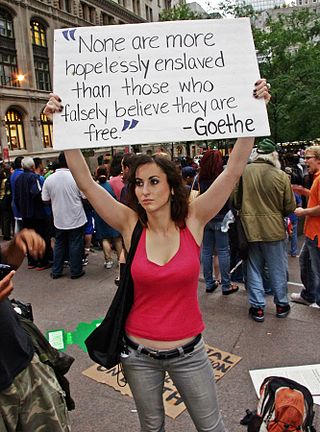
The following is a timeline of Occupy Wall Street (OWS), a protest which began on September 17, 2011 on Wall Street, the financial district of New York City and included the occupation of Zuccotti Park, where protesters established a permanent encampment. The Occupy movement splintered after NYC Mayor Bloomberg had police raid the encampment in Zuccotti Park on November 15, 2011. The timeline here is limited to this particular protest during this approximate time-frame.

The Occupy movement was an international populist socio-political movement that expressed opposition to social and economic inequality and to the perceived lack of real democracy around the world. It aimed primarily to advance social and economic justice and different forms of democracy. The movement has had many different scopes, since local groups often had different focuses, but its prime concerns included how large corporations control the world in a way that disproportionately benefits a minority, undermines democracy and causes instability.
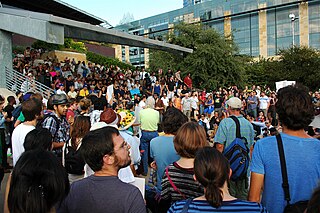
Occupy Austin was a collaboration that began on October 6, 2011 at City Hall in Austin, Texas as an occupation and peaceful protest. It is affiliated with the Occupy Wall Street movement that began in New York City, and also with the "Occupy" protests in the United States and around the world. At the center of the occupation is the General Assembly, where the community comes out and tries to come to consensus on proposals for action.

Occupy Chicago was an ongoing collaboration that included peaceful protests and demonstrations against economic inequality, corporate greed and the influence of corporations and lobbyists on government which began in Chicago on September 24, 2011. The protests began in solidarity with the Occupy Wall Street protests in New York.

The 15 October 2011 global protests were part of a series of protests inspired by the Arab Spring, the Icelandic protests, the Portuguese "Geração à Rasca", the Spanish "Indignants", the Greek protests, and the Occupy movement. The protests were launched under the slogan "United for #GlobalChange", to which the slogan "United for Global Democracy" was added by many people's assemblies. The protest was first called for by the Spanish Plataforma ¡Democracia Real YA! in May 2011 and endorsed by people's assemblies across the world. Reasons were varied but mainly targeted growing economic inequality, corporate influence over government and international institutions, and the lack of truly democratic institutions allowing direct public participation at all levels, local to global. Global demonstrations were held on 15 October in more than 950 cities in 82 countries. The date was chosen to coincide with the 5-month anniversary of the first protest in Spain. General assemblies, the social network n-1, mailing lists, Mumble voice chat, open pads such as Pirate Pad and Titan Pad, and Facebook were used to coordinate the events. Some protests were only a few hundred in number, whereas others numbered in the hundreds of thousands, with the largest in Madrid numbering half a million and the second largest city Barcelona with 400,000.
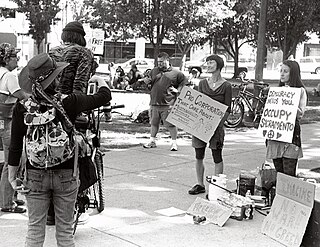
Occupy Sacramento was a collaboration occurring in Sacramento, California. Occupy Sacramento included peaceful protests and demonstrations. On October 6, 2011 a group of 200 protesters began demonstrating at César E. Chávez Plaza, located directly in front of Sacramento City Hall, as part of the "Occupy" protests. Those in attendance began a march to the California State Capitol at 10:00 AM without a proper permit to demonstrate at that location. Some arrests were made later that night.
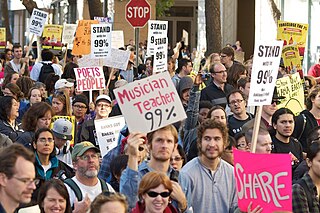
Occupy Oakland refers to a collaboration and series of demonstrations in Oakland, California, that started in October 2011. As part of the Occupy movement, protestors have staged occupations, most notably at Frank H. Ogawa Plaza in front of Oakland City Hall.

The Occupy movement began in the United States initially with the Occupy Wall Street protests in New York City, but spread to many other cities, both in the United States and worldwide. This list article is an alphabetical, non-chronological summary of Occupy events that have occurred in cities in the United States.
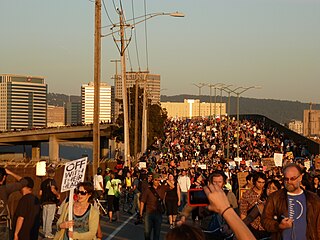
The following is a timeline of Occupy Oakland which began on Monday, October 10, 2011, as an occupation of Frank H. Ogawa Plaza located in front of Oakland City Hall in downtown Oakland, and is an ongoing demonstration. It is allied with Occupy Wall Street, which began in New York City on September 17, 2011, and is one of several "Occupy" protest sites in the San Francisco Bay Area. Other sites include Occupy San Francisco and Occupy San Jose.

Occupy Redwood City was a collaboration that began with peaceful protests, demonstrations, and general assemblies in front of the historic San Mateo County Courthouse in Redwood City, California. The demonstration was inspired by Occupy Wall Street and is part of the larger "Occupy" protest movement.
Occupy Vanderbilt was a collaboration that included demonstrations and an occupation located at Alumni Circle Lawn at Vanderbilt University in Nashville, Tennessee. Occupy Vanderbilt engaged in organized meetings, events and actions through March 2012. The occupation was in solidarity with the global occupy movement and Occupy Nashville, and is notable as the first protest encampment at Vanderbilt, the spread of which in countries like Argentina, Greece and Spain originally inspired the Occupy movement.
The Occupy movement has been met with a variety of responses from local police departments since its beginning in 2011. According to documents obtained by the Partnership for Civil Justice Fund, the FBI, state and local law enforcement officials treated the movement as a potential criminal and terrorist threat and used fusion centers and counterterrorism agents to investigate and monitor the Occupy movement.

Demonstrations were held throughout the United States on Presidents Day, February 18, 2019, in protest of President Donald Trump's declaration of a national emergency to construct a new wall extending the barrier along the southern border. Because schools were closed on Presidents Day, many young people were able to participate.